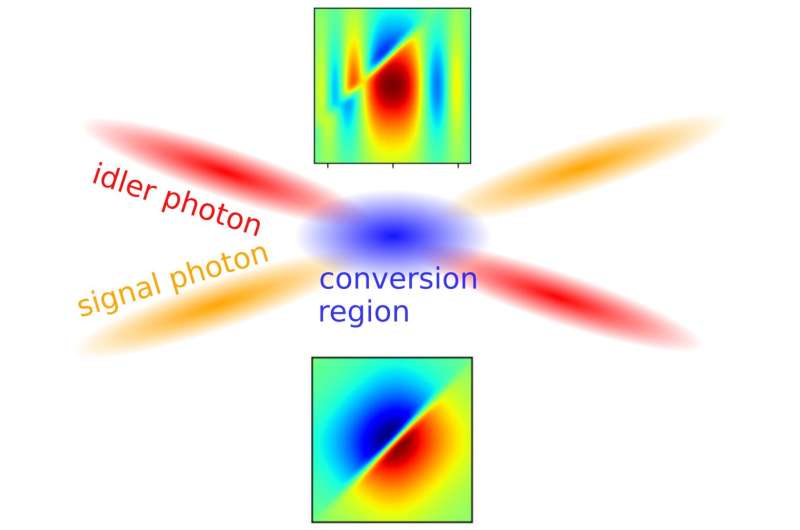April 11, 2022 feature
Study highlights the possibility of building wave-shape-tolerant qubit gates

Quantum computers, machines that leverage quantum states to perform computations and store data, could soon revolutionize the computing industry, achieving significantly greater speeds and performance than existing computers. While countless companies worldwide, including Google and IBM as well as smaller start-ups, have started working on quantum technologies, the exact architecture that will lead to their mass production remains unclear.
Researchers at Leibniz University Hannover have recently conducted a theoretical study investigating the possibility of realizing flying-qubit gates for quantum computers that are insensitive to the wave shapes of photons, and also fully preserve these shapes during processing. Their paper, published in Physical Review Letters, could serve as the basis for the development of new gates that can process entangled photonic wave packets more effectively than unentangled ones.
"There are several candidate architectures for the development of quantum technology, including superconductors, ion traps, solid state, optical, and so on," Ihar Babushkin, one of the researchers who carried out the study, told Phys.org. "Regardless of what architecture we consider, photons, the quanta of light, will play an important role, since in almost all architectures the mediators between quantum information bits (qubits) are photons."
Optical quantum computers stay here separately, since the photons do not only mediate interaction between the qubits; they are also qubits themselves. As the photons are not affected by decoherence (i.e., a process through which the environment interacts with qubits and changes their quantum states, causing the loss of information they are storing), they are ideal for safely carrying quantum information.
"For photons, decoherence is not a problem because photons do not interact with photons, and barely interact with matter," Babushkin explained. "However, this becomes a problem as soon as we want to manipulate photons: the lack of interaction makes it difficult to manipulate photons and therefore makes it difficult to perform quantum computations. Despite this, teams worldwide continue conducting research in this direction, because photonic information processing is extremely attractive, if it can be realized, as it can be done at room temperatures."
One existing approach for photonic information processing is known as "measurement-based computation." This approach only requires linear elements, such as beam splitters and the measurement of ancillary photons.
An alternative method is coherent photon conversion (CPC). This is a technique that amplifies nonlinear optical interactions, processes through which four waves are mixed between photons, using an additional, powerful laser beam.
Despite their differences, these two different approaches share a common limitation. Specifically, they both, as it was believed up to now, require input photons that are "identical" (i.e., indistinguishable and uncorrelated to each other in time and space).
"This requirement is needed because otherwise photons become distinguishable, breaking their quantum interference," Babushkin said. "This is a severe limitation, since it requires that all the photons are produced with completely independent yet identical photon sources. Producing many identical photons is not an easy task."
In their paper, Babushkin and his colleagues showed that this could be achieved using a variant of the CPC method. More specifically, they theoretically demonstrated that CPC could be used to realize flying-qubit gates that work equally well for correlated, nonidentical, distinguishable photons, preserving their spatio-temporal photonic properties while operating. To do this, they used a variant of a CPC approach proposed by a team at Macquarie University and Imperial College.
"In this approach, both the interacting photons and the strong laser pump propagate with different velocities and meet at some point," Babushkin said. "We showed that in this case the photon interaction appears in the form of a sharp interaction front, which can be as small as hundreds of attoseconds in time (one attosecond is 10-18 of second) and few nanometers in space. The size of this front is determined by the maximal speed with which atoms can react to the optical excitation."
Babushkin and his colleagues showed that using their approach, as soon as the waveshape (i.e., pulse shape) of the interacting photons is much larger than the attosecond scale, which is always the case for optical frequencies, the separate pieces of the photonic waveshapes are processed independently. As a result, the waveshape of the photons in the system remains untouched.
"We think our main achievement is that we showed that it is possible to create gates that work in a waveshape-independent, waveshape-tolerant way," Babushkin said. "Such possibility was not evident, in opposite, it was believed that such gates were impossible."
In the future, the hypothesis introduced by this team of researchers could be experimentally tested in the lab, to confirm whether their theoretical predictions are true. If they are, their work could pave the way towards the development of better performing photonic information processing systems.
"As the next step in our research, we will attempt to experimentally realize the theoretical notions we introduced," Babushkin added. "If we succeed, we will extend our single-gate result to the entire framework in which all computations are made in the waveshape-tolerant way. In more distant future, this can lead to easier realization of purely photonic quantum computers."
More information: I. Babushkin et al, Wave-Shape-Tolerant Photonic Quantum Gates, Physical Review Letters (2022). DOI: 10.1103/PhysRevLett.128.090502
E. Knill et al, A scheme for efficient quantum computation with linear optics, Nature (2002). DOI: 10.1038/35051009
N. K. Langford et al, Efficient quantum computing using coherent photon conversion, Nature (2011). DOI: 10.1038/nature10463
Keyu Xia et al, Cavity-Free Scheme for Nondestructive Detection of a Single Optical Photon, Physical Review Letters (2016). DOI: 10.1103/PhysRevLett.116.023601
Journal information: Nature , Physical Review Letters
© 2022 Science X Network




















